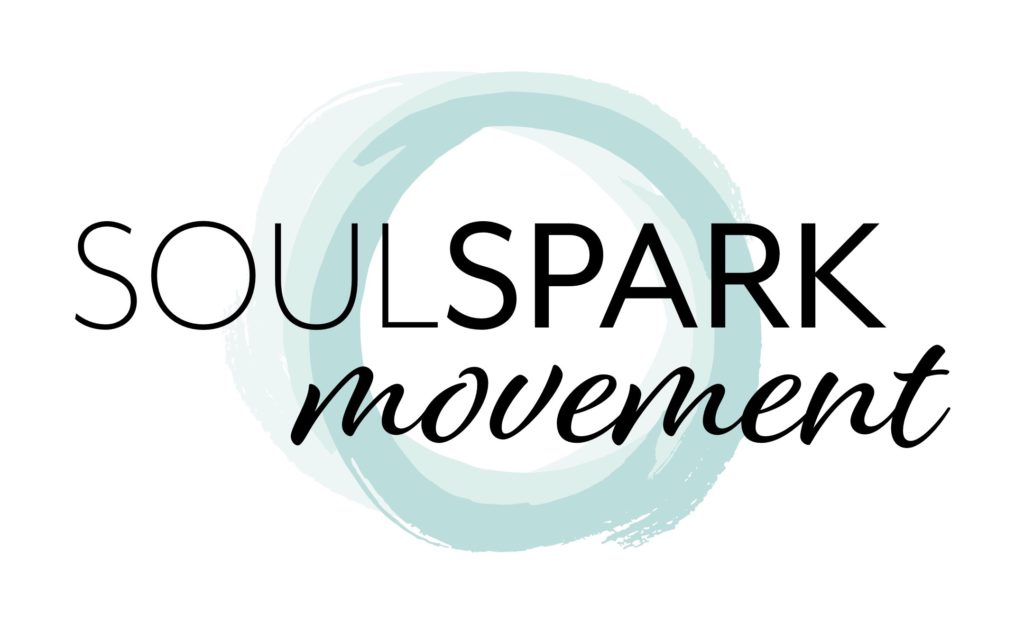My Story
I was not always this way: a warrior for self-love, a shunner of talk of diets and waistlines, a teacher of mindful movement, and an advocate for wholeness. I feel that in order to properly introduce myself and share my message with you, I have to start with my past. My past is filled with darkness and shame. Self-loathing. Here is the story that defines me and guides me to do the work that I do.
You see, I had an eating disorder in college. I don’t even know how to put into words how uncomfortable I was in my own skin, in my own being. Have you ever worn clothing that you loathed? Clothing that you felt so uncomfortable in that no matter how you pulled or pried at the fabric, it never seemed to fall in the right place. Outfits like that drive you to distraction and all you can think of is that foreign feeling, and getting out of it. That’s how I used to feel in my own body, like if I could just slide out of the skin encasing me I could perhaps finally feel free and comfortable. My body was a prison.
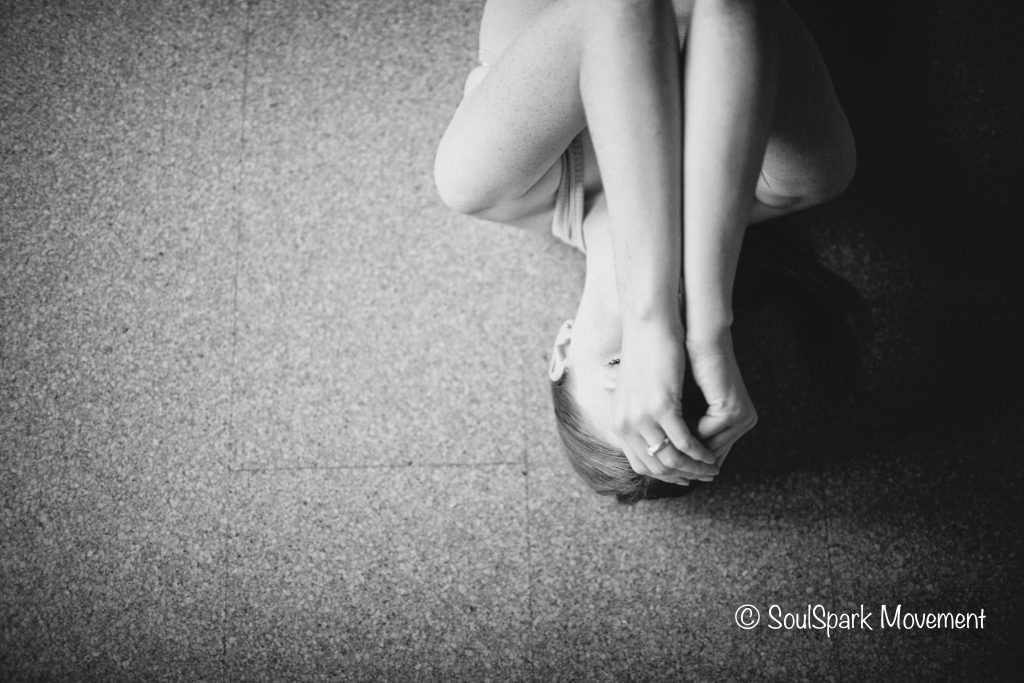
It Started Young
How does one reject her own body so completely? Well, that was a hell that took me years to build. I cannot ever remember as a child not feeling at least a little bit self-conscious about my appearance. It started with hating my freckles. As much as people told me they were cute sun kisses, I saw them as speckles, shameful blemishes on my face. I was savvy enough to look around and know that the women who were considered beautiful had smooth, flawless complexions. So even at the age of seven, it was something I desperately wished away.
So young, you ask? It doesn’t take long for girls to get the message from the world that their appearance is their most valuable part. From before they are even old enough to remember, girls are complimented on their looks, dressed up like dolls, told to twirl around in their dresses, put on a show, but cover up enough. Be nice to look at. That’s what matters.
Men are told that all women need to hear that they are beautiful, so they think they are being generous in praising our looks. But why? Why should a woman have to be told she’s beautiful in order to feel worthwhile? Simply because the world believes that only beautiful women are worthwhile. Boys aren’t told to build the foundation of their worth in something so fragile, faulty, and subjective because a pleasing appearance is not an essential attached to their identity. They’re not taught to objectify themselves, to always consider how they look from the outside in.
But I was. Now don’t get me wrong, I was taught true, deeper realities of my worth. But of all the messages that were thrown at me, “Beauty Matters” is the one that I heard loud and clear. It sunk in deep and over time changed my perception of myself. I find it strange that the message of beauty can be so damning to so many. You know, beauty: “the quality or aggregate of qualities in a person or thing that gives pleasure to the senses or pleasurably exalts the mind or spirit.” Outer beauty can be defined as exalting the spirit, but for so many women, it is more a cage, a social construct we are expected to pay homage to. You know, so men will want us and other women will want to be us.
A gilded cage, maybe. But a cage nonetheless.
And because my self-worth was built on faulty principles of perfectionism and people-pleasing, because I thought something was inherently wrong with me inside, this is a cage I crawled in to, thinking it would buy me confidence, love, and freedom from pain and rejection.
But these are the things “beauty” taught me: that my worth was determined by if I caught someone’s eye, and that desirable women are thin.
Swim in lies long enough and they start to sink in through your skin, permeating your being, like water through paper. I can remember as a small child sliding my nightshirts off of one shoulder and practicing sultry looks in the mirror. I’d roll my undershirts up so it looked like I didn’t have a flat chest. Where I got these ideas that this was what a woman should do and be, I don’t know, but all of this formed within me before I had even learned my times tables.
By the time I was in sixth grade I had joined in the culture of self-body-bashing talk, calling my thighs thunderous. That’s also when I really knew and cared about the fact that I didn’t have the looks that the boys my age were typically drawn to. I knew they liked my personality more than my appearance, and instead of being glad that they liked being around me more than the other girls, I was sad that my friends were prettier than I was.
By the time I got to high school things changed. I started to get some attention for my looks. This only fueled that destructive fire. I was finally getting the attention that I had craved. It wasn’t for working hard in school and being smart, for making people laugh, for being kind, or being faithful to my religion. It was because I had learned more of what to do to be considered hot. Getting noticed for your looks can be pretty heady, and all I wanted was more. So, I started to form dietary habits that went along with this focus on only the outer things. Rules came into being: no eating after 8 pm, only drinking water, eating my morning toast completely plain, minuscule lunches, the list goes on. As time went on, I spoke less and less about my feelings to others, asking nothing of them, playing it cool, hiding more of my inside world as I got more attention for what I presented on the outside.
Shame Becomes the Driver of My Life
I really got into trouble when I moved out on my own for college. Like many girls do, I put on weight. I was completely devastated and obsessed with rectifying the situation. By this point I was thoroughly convinced that my looks should be my highest priority. This is when shame took over my life, whereas before it had only been a persistent passenger. As I acted on all that shame and hate, the behaviors became more entrenched. I knew I was in trouble, but I felt if I let go of all my rules, that my life would completely fall apart and everyone would find out what a mess I was inside.
The more I pursued glamour, and thinness, the more it left me feeling empty. My personality was slowly packed away into a box inside. And then the box got lost in the hustle to be worth something. I forgot who I was. All I could think about was how much I weighed, how I looked to others, and the vast ravine I had built to keep others away so I could hide the chaos inside. This ravine was hollowed out by perfectionism, appearances, and shame. Me on one side, everyone else on the other. I felt desperately lonely, but terrified to build a bridge across that vast distance because I didn’t believe that they would love the broken spirit they would find if they crossed that bridge.
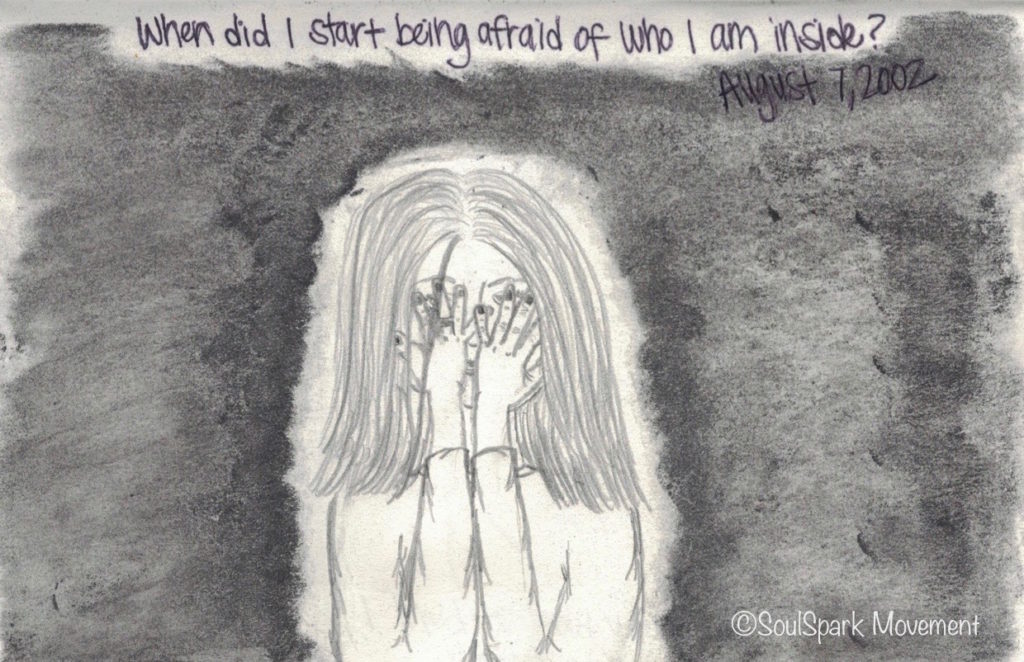
You see, my quest for beauty (insert: worthiness and love) caused me to objectify myself so much that I rejected my own body. It became separate from who I was. There was a broken Me inside, and then there was my body: my enemy, and my savior. My body was the reason for my unhappiness and loneliness; I thought I could fix that by fixing my appearance.
My diet and exercise regime was the way I tried to feel a sense of control through the storm that was raging within. I obsessed over calories, measured my food, had an extensive list of foods that I wouldn’t eat, and a no-eating-after-8-pm rule, hungry or not. I had an intense fear of being fat and was ashamed of my curves. I preferred eating alone because if anyone spoke about what I was eating, thereby drawing attention to what I was doing, I felt ashamed. I overate sometimes and would feel out of control. Because I felt so disgusted with myself I would try to make myself throw it all up until I’d end up crying and shaking on the bathroom floor (I could never actually purge). So instead I’d go running or take laxatives, and make stricter rules for myself to follow. I weighed myself obsessively: before a workout, after a workout, before dance class, after dance class, just because the scale was there, multiples times a day, day after day, month after month after month.
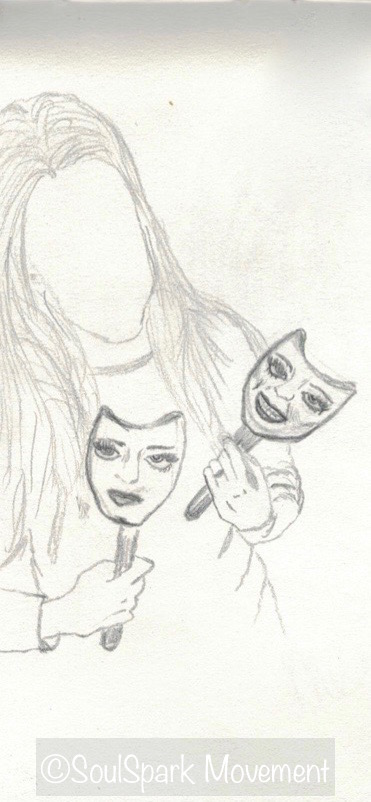
I wrote in my journal every day for years about hate. Hating myself. Hating my body, feeling trapped inside it. The real me inside was shrinking, terrified to feel so small, wanting to claw her way back to the surface, but so scared too, because I thought that the real me was flawed beyond repair. I’d devoted years of my life to thinking no one could love me for me, that if I was noticed it was because of my body, that if I was rejected it was also because of my body. My body was a prison, my shame the guard.
I felt like I was drowning in silence. I once drew a self-portrait with a blank face and masks in my hands because I didn’t know who I was and all I ever did was put on a show.
All this time I was going to school, hanging out with roommates, kissing boys, pursuing my dream of majoring in dance. I looked healthy. No one really knew the depth of the darkness I was trapped in because I worked really hard to maintain appearances, in all senses of the word. I was fake. And didn’t know how to be real again. But oh! how I longed to be.
It got to the point that the only compliments I ever got from boys were on my looks. I know they thought they were telling me what I wanted to hear, but the me inside cried out in pain every time. I was scared that perhaps that’s all there really was left to me anymore, just a shell that would eventually grow old and fade away into oblivion, unknown by even those closest to me.
My Turning Point
This went on and on for most of my college years. I cried out in prayer countless times for an end to all of this. And then one day, I was sitting in an institute class (a religion class for young adult members of my church) and the teacher got up, said he needed to put away his lesson plan for the day, and proceeded to speak about how some of us had beliefs about ourselves that were making us unhappy. My heart cried out in relief to hear that truth, to even imagine that I didn’t have to live this way. And that was the turning point for me in the very long, arduous, uphill journey of loving myself, imperfect-bodied, shattered-soul Me.
I ended up going to a counselor as an out-patient at an eating disorder clinic once a week, going to a dietitian once a week, taking anti-depressants, gaining (and then losing) a lot of weight, and nearly flunking out of all of my classes one semester in college (this coming from a girl who was always on the honor roll in school) while I tried to pick up the pieces of my broken life.
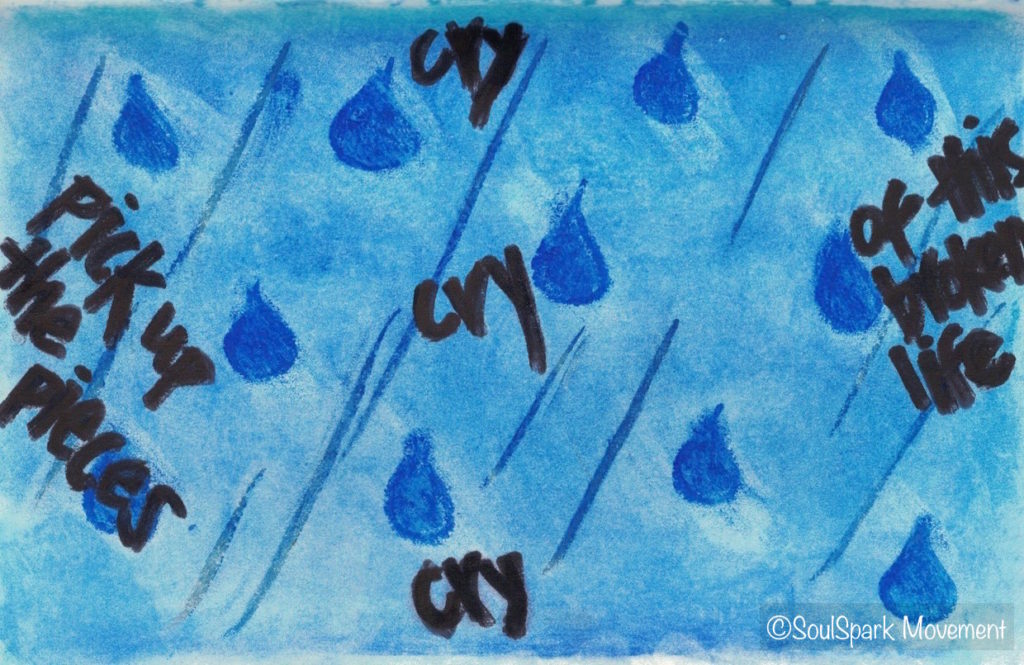
During that time I tried to hide from the world as best I could as I labored to love myself as I was, to no longer be afraid of who I was inside, to be imperfect. It was a hard battle, but it was a battle I kept fighting and somehow it stopped being a fight and actually a way of living. I’m not going to lie, it took years.
It’s taken me months to write the story of those dark times, to get the words to ring true to my actual experience. It’s strange to have memories that are so foreign from my reality now. Was I really so imprisoned by my own shame? Looking back at this to tell it truthfully has been like looking through a dark, watery tunnel, where my vision becomes distorted by what I see. When I resurface I can see that I’ve stopped hurting myself, but I haven’t quite learned to stop hiding. There are still parts of me packed away in that box. You know, the one that I packed my real self away in so that people would like me, or at least, not hurt the real Me. My perfectionism and people-pleasing tendencies have branched off in countless directions, infiltrating all parts of my being, like the small fibers of a weed spreading through soil. Body hatred was just one of the ways it manifested. Ridding myself of all those small fibers completely will perhaps be a work of a lifetime. But that is work I will gladly do, because I love myself.
I’m grateful for my past, because the things I learned to get out of that oppressive darkness then have become my guiding light now. My recovery was such a slow and arduous process that I can not do it justice with just one blog post. It came in pieces, so that’s how I’ll have to share it with you: in pieces. Which makes sense really, because I, myself, was in pieces, and fitting Me back together has been much like solving a puzzle without a picture to follow. But this puzzle has become my love story. Not just for myself, but the one I feel driven to share with the world. And share it I will. Because the light and joy that I feel now, the sense of wholeness I get from moving my body and all the other things that have made me well, those are the things that I feel driven to share with you.
What is your story? Are there parts of my past that resonate with yours?
(To begin reading about my recovery, click here.)
Save
Save
Save
Save
Save
Save
Save
Save
Save
Save
Save
Save
Save
Save
Save
Save
Save
Save
Save
Save
Save
Save
Save
Save
